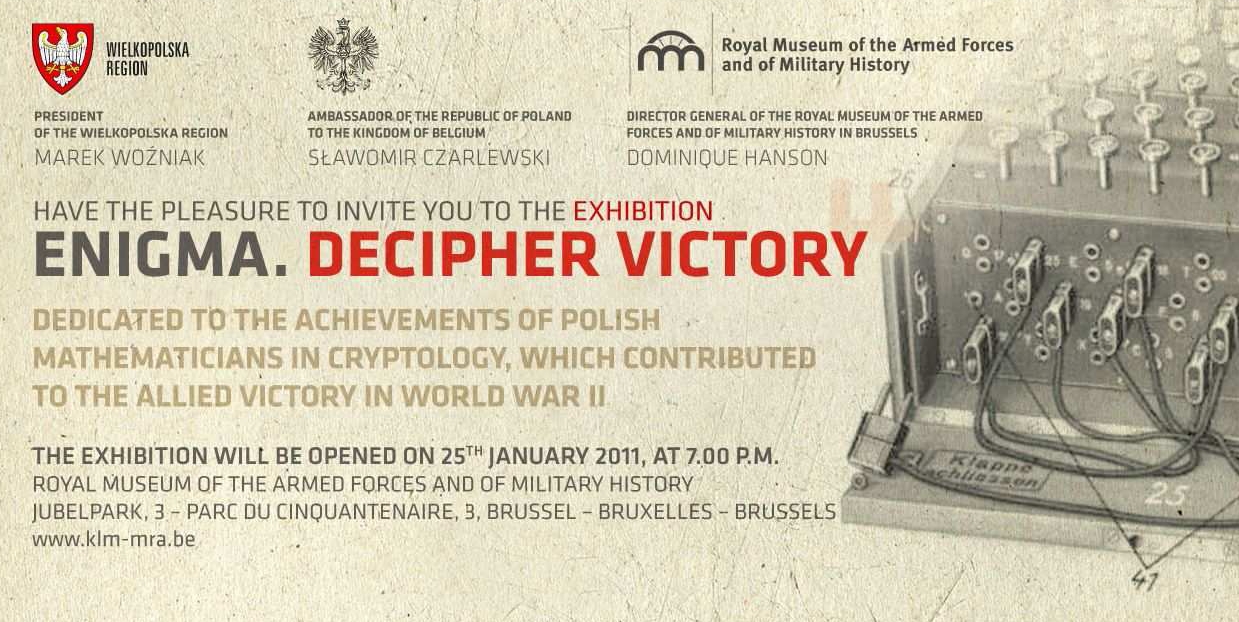 The opening of the exhibition “Enigma. Decipher Victory” will take place on 25 January 2011 at 7pm in the Royal Museum of the Armed Forces and of Military History in Brussels (Jubelpark 3 – Parc du Cinquantenaire 3). The exhibition, which evoked much interest in December, is organised jointly by Marek Woźniak, President of the Wielkopolska Region, Sławomir Czarlewski, Ambassador of the Republic of Poland to the Kingdom of Belgium, and Dominique Hanson, Director General of the Royal Museum of the Armed Forces and of Military History in Brussels.
The opening of the exhibition “Enigma. Decipher Victory” will take place on 25 January 2011 at 7pm in the Royal Museum of the Armed Forces and of Military History in Brussels (Jubelpark 3 – Parc du Cinquantenaire 3). The exhibition, which evoked much interest in December, is organised jointly by Marek Woźniak, President of the Wielkopolska Region, Sławomir Czarlewski, Ambassador of the Republic of Poland to the Kingdom of Belgium, and Dominique Hanson, Director General of the Royal Museum of the Armed Forces and of Military History in Brussels.
The exhibition is unique as to its form and content. It presents the history of extraordinary men, modest and unknown heroes – Polish mathematicians, cryptographers whose activity helped to save millions of people during World War II.
“Enigma. Decipher Victory” is an exhibition dedicated to the achievements of mathematicians of Poznań University in deciphering the codes of the famous German Enigma, an encryption machine. The underlying objective of the exhibition, introduced by means of thematic tables, is to present the lives of those whose skills and unusual knowledge contributed to one of the more spectacular successes in world cryptology, a turning point in the complex process of curbing the madness of mutual annihilation. Furthermore, it helped to curtail World War II by 2 to 3 years, thus protecting Europe from the spectre of total destruction.
The protagonists of the exhibition: Marian Rejewski, Jerzy Różycki and Henryk Zygalski, revolutionised cryptology; apart from deciphering the Enigma codes, they laid the mathematical foundations for cipher attacks. However, it was only in the mid-1970s that the world learned about their role and accomplishments. For many this history remains unknown until today…
In its prestigious venue, the Royal Museum of the Armed Forces and of Military History in Brussels, the exhibition will continue until the end of March 2011, revealing many more intriguing aspects of this exciting history.
It is also part of consistent actions taken by President Marek Woźniak, who has for years promoted knowledge of the Polish scholars and staff of the Cipher Bureau. His noteworthy initiatives include, for example, the transferring in November 2008 to the town of Szamotuły in the Region of Wielkopolska of the ashes of Lt. Colonel Maksymilian Ciężki, head of the German section of the Cipher Bureau before World War II. In July 2009 an exhibition dedicated to Ciężki was launched during the Polish Day in the museum in Bletchley Park, UK, which during the war was the headquarters of a secret decryption centre. This exhibition was also held in Poznań. In turn, in December 2010 the history of mathematicians from Wielkopolska, presented as an intriguing labyrinth, was available to visitors to the European Parliament.
The launching of the exhibition in the Royal Museum of the Armed Forces and of Military History in Brussels, targeted mainly to young Belgians and the international community in Belgium’s capital, is accompanied by a colour brochure and a puzzle cube.
Successive editio's of this exhibition are planned across Europe.
Author: Marshal Office of the Wielkopolska Office







